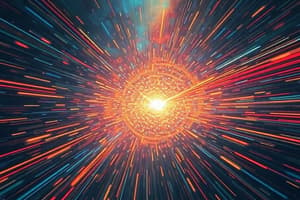Podcast
Questions and Answers
What is the driving force behind motion?
What is the driving force behind motion?
Which force opposes motion, causing objects to slow down or come to a stop?
Which force opposes motion, causing objects to slow down or come to a stop?
What is the force that keeps objects from floating off into space?
What is the force that keeps objects from floating off into space?
What type of force can be found in everyday life, causing objects to slow down or stop?
What type of force can be found in everyday life, causing objects to slow down or stop?
Signup and view all the answers
Which physicist's laws of motion describe the relationship between forces and motion?
Which physicist's laws of motion describe the relationship between forces and motion?
Signup and view all the answers
What type of action can forces perform to objects?
What type of action can forces perform to objects?
Signup and view all the answers
What is responsible for the operation of devices such as electric motors and generators?
What is responsible for the operation of devices such as electric motors and generators?
Signup and view all the answers
According to Newton's laws of motion, what is directly proportional to the net force acting on an object?
According to Newton's laws of motion, what is directly proportional to the net force acting on an object?
Signup and view all the answers
What keeps us grounded on the Earth's surface?
What keeps us grounded on the Earth's surface?
Signup and view all the answers
What are students in grades 3 and up encouraged to explore through hands-on activities in science education?
What are students in grades 3 and up encouraged to explore through hands-on activities in science education?
Signup and view all the answers
In Newton's laws of motion, what is stated to happen for every action?
In Newton's laws of motion, what is stated to happen for every action?
Signup and view all the answers
What concept provides a framework for understanding the relationship between forces and motion?
What concept provides a framework for understanding the relationship between forces and motion?
Signup and view all the answers
Study Notes
Forces and Motion: Foundation for Understanding Physical World
Everything moves, whether it's an object that we can see or the atoms that make up everything around us. Understanding how motion works is a crucial foundation for understanding the physical world, and much of this understanding can be attributed to Sir Isaac Newton's laws of motion.
Forces and Motion: What's the Connection?
Forces and motion are interconnected concepts. Forces are the driving force behind motion, causing objects to move, change direction, and even come to a stop. The motion, in turn, can take many forms, such as a shift in direction or a change in an object's shape.
What are Forces?
Forces are a pushing or pulling action that can make things move, change direction, or change shape. Consider kicking a ball, which involves applying a force (a push with your foot) that makes the ball fly upward into the air. Newton's laws of motion, which describe the relationship between forces and motion, have been instrumental in our understanding of these concepts.
Types of Forces: Gravity, Friction, and More
There are various types of forces, including:
- Gravity: The force that pulls objects towards the center of a planet, such as Earth. It's what keeps us from floating off into space.
- Friction: The force that opposes motion, causing objects to slow down or come to a stop. This force can be found in everyday life, as when a ball rolls across the floor and eventually stops.
- Magnetism: The force that attracts or repels magnets and ferromagnetic materials. This force is responsible for the operation of many devices, such as electric motors and electric generators.
Forces and Motion in Our Daily Lives
Forces and motion are all around us, influencing our daily lives in numerous ways. For example, gravity keeps us grounded, friction helps us walk, and magnetism powers our electronic devices. Understanding these concepts can help us better navigate the physical world and appreciate the complex interplay of forces that govern it.
Newton's Laws of Motion
Newton's laws of motion, first introduced in the 17th century, provide a framework for understanding the relationship between forces and motion. These laws state that:
- An object will remain at rest or in uniform motion unless acted upon by a force.
- The acceleration of an object is directly proportional to the net force acting on it and inversely proportional to its mass.
- For every action, there is an equal and opposite reaction.
The Role of Forces in Science Education
In science education, understanding forces and motion is a critical component of learning about the physical world. Students in grades 3 and up are encouraged to explore these concepts through hands-on activities and experiments, helping them gain a deeper understanding of how forces shape our world.
In conclusion, forces and motion are integral parts of our physical world, shaping our everyday experiences and influencing the functioning of many devices and systems. By understanding these concepts, we can gain a deeper appreciation for the complex interplay of forces that govern our world.
Studying That Suits You
Use AI to generate personalized quizzes and flashcards to suit your learning preferences.
Description
Test your knowledge of forces and motion, the fundamental concepts that govern the physical world. Explore the connection between forces and motion, types of forces like gravity and friction, and Newton's laws of motion that define these relationships.




